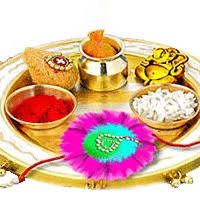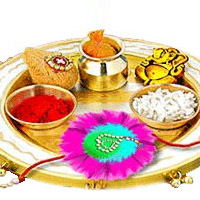Raksha Bandhan
The applying of Tilak on a brother’s forehead by a sister should remind him of the true identity and image of his inner self as a point of light from between eye brows, and the colored thread around the wrist should signify one’s pledge for purity in life and promise for fellow feeling hi society.
Greek Hero Alexander during his attack on Porus kingdom, had received a rakhi and request from Porus’s wife to save her husband’s life in the battle field.
 Rakhi, a symbol of spiritual bonding
Rakhi, a symbol of spiritual bonding
The auspicious occasion of Rakhsha Bandhan which fall every Sharvan Pirnima has been described in Hindu scriptures as a Punyapardayak (merit giving) and Vistodak (vice demolishing) It carries great mythological ,historical, cultural and spiritual significance. (This year it falls on 9 August)
Many mythological stories have gained currency on the origin of this religious observance. As per one story which probably serves as the basis for the beginning of the historical and cultural practice and practice of sisters tying Rakhi to their brothers depicts the rakhi tying ceremony between Yama (Lord of death) and his sister Yamuna. Highly pleased by the purity and serenity of the ceremony, the Lord of Death declares that whosoever ties rakhi from a sister, well ever remain free from the fear of Yamdootas. (emassiries of Yama)
Historically, the observance of rakhi between brother and sister took on a measure of expediency and expectation when during several foreign invasions starting from Greeks to Muslims. Hindu ladies used to send rackhis to the invaders in anticipation of latter’s offer of protection. It is said that Greek Hero Alexander during his attack on Porus kingdom, had received a rakhi and request from Porus’s wife to save her husband’s life in the battle field. Moreover, Mughal emperors like Humayun, Akbar etc. were known to have extended their hands to help and brotherhood to Hindu queens and ladies in the hour of need, as a mark of respect to their “Rakhi sisters”. When a sister ties rakhi to her brother, she spiritually seems to inspire him to see other’s sisters as his own and not to look upon them with lecherousness.
Rakhi ritual, in reality, reveals such rich inner meanings and healthy implications which are worthy of inculcation by one and all. The applying of Tilak on a brother’s forehead by a sister should remind him of the true identity and image of his inner self as a point of light from between eye brows, and the colored thread around the wrist should signify one’s pledge for purity in life and promise for fellow feeling hi society. Similarly, sharing sweets between brother and sister on the day of Rakhi induces us to be soft and sweet in our speech, manners, and interactions, while the practice of presenting gifts in cash or kind to the sister in return for rakhi, essentially entrusts os us the task of self transformation by surrendering and sublimating our innate vices. I.e. lust, greed, anger, ego, attachment, idleness etc, in the subtle fire of self introspection, divine contemplation and spiritual fellowship with others in society.
If all of us understand these higher meanings and wisdom behind the RAKHI rituals and observe them as lifelong process of practicing and promoting human, moral, cultural social and spiritual values and empowerment it will help to restore positivity and virtues in life and society which the rakhi festival epitomizes.
We will then be said to have really bound 9Bandhan) ourselves with the sacred string of God’s selfless love and protection ( Rakhsha) when we pledge purity, vrtuosity, spiritual strength and righteousness in thoughts, words, and deeds and when we resolve to co-operate and endeavor for the establishment of a peaceful, non voilnet, healthy and harmonious society by remaining in loving and powerful communion with the Almighty Supreme Soul, the eternal fountain of true peace, purity and power.























